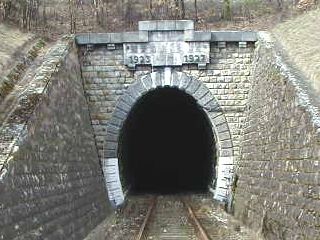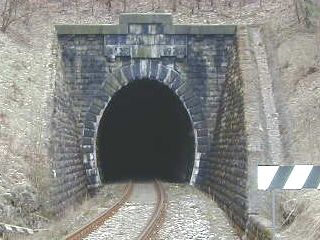SK
Tunel Generala M.R.Stefanika (Pod Polanou, Myjavsky)
Stavba tunela pod hrebenom Polany predstavovala v case svojho vzniku jedno z najvacsich technickych diel republiky. Tunel generala Stefanika aj dnes vzbudzuje znacnu pozornost v odbornych kruhoch i v sirokej verejnosti.
Vystavba tunela
Vystavbu tunela, s jednorocnym predstihom, 8.7.1923 slavnostne otvoril minister zeleznic Jiri Stribrny za pritomnosti ministra polnohospodarstva dr. Milana Hodzu, ministra pre zjednotenie zakonov a organizaciu spravy JUDr. Ivana Markovica a dalsich zastupcov verejnych organov a tlace. Urobili prvy vykop tuneloveho zarezu.
U oboch buducich tunelovych portalov vznikli rozsiahle nadvoria so strojarnami a dielnami, stavebnymi zeleznicami sa dopravoval na nadvoria stavebny material. Material na stavbu bol dopravovany povozmi - k portalu na moravskej strane zo stanice Veseli nad Moravou. Zo slovenskej strany bolo nadvorie zasobovane uzkorozchodnou stavebnou zeleznicou az z horneho okraja Myjavy.
Po oboch stranach Polany zriadili lomy na tazbu kamena pouzivaneho na murivo tunela i na vyrobu strku a piesku drvenim. Okrem tychto lomov kvalitny kamen dovazali z lomu U Skalskych (dnesna cast obce Rudnik) i zo vzdialenejsich lokalit. S razenim spodnej smerovej stolne zacali z oboch stran hory, zo strany moravskej v auguste a slovenskej v septembri 1923.
Z vrboveckej strany sa pracovalo rucne rychlostou 1,5m az 2m za den, z brestoveckej bol pomocou pneumatickych vrtacich kladiv postup 3m az 4m za den. Priemerny denny postup pri stavbe tunela bol v roku 1925, ked prace boli v plnom prude, zhruba 3,3m, v roku 1926 4,5m. Tunelova rura bola vydrevenena silnymi tunelovymi typmi v pasoch spravidla 8 m dlhych. Najvacsia vyska nadlozia, tj. vzdialenost klenby tunela od povrchu hory dosahuje asi 170m. Tunel lezi v priamke a na brestoveckej strane konci miernym oblukom s polomerom R=1000m.
Pri stavbe tunela sa po prvykrat vo vacsom rozsahu pouzilo mechanizacie. Asi dve tretiny prac na vystavbe tunela sa robilo z nadvoria zo slovenskej strany. Elektricka energia pre cele toto stavenisko sa vyrabala priamo na nadvori pomocou generatorov pohananych naftovymi motormi. Naftove motory s celkovym vykonom 294kW sluzili pre pohon kompresorov, vrtacich kladiv systemu Flottmann, ventilatorov pre vetranie v tuneli. Kompresory tlacili vyrobeny vzduch potrubim tunela priamo k vrtackam. Elektorgeneratory vyrabali elektricku energiu, ktora sa pouzivala na osvetlovanie a na pohon ventilatorov. Instalacia bola zariadena tak, aby pri vyskyte triestivych plynov sa dalo premenit prechodne vetranie na odsavanie.
Pri najvacsom rozmachu tunelovych prac bolo zamestnanych 1443 robotnikov. Prace prebiehali nepretrzite vo dne i v noci. Robotnici byvali v okolitych obciach, ale pre viac ako 300 robotnikov boli postavene obytne baraky priamo pri tuneli. Prevazna vacsina bola z CSR, iba mineri boli Slovinici z Juhoslavie a Talianska, tvoriaci jednu tretinu pracovnikov.
Pracovne i platove podmienky, javiace sa spociatku ludom, ktori dlhe roky nemali kde "zavadit o korunu", ako prijatelne, sa vsak neprestajne zhorsovali. Pri vystavbe tunela museli i napriek tomu, ze existovala znacna nezamestnanost, pracovat i 10 hodin denne a casto sa s nimi hrubo zaobchadzalo. Kedze stavebne firmy mali v kraji dostatok pracovnych sil, usilovali sa vyuzit miestnu situaciu na zvysenie vlastneho zisku maximalnym znizovanim miezd.
Takmer za tri roky od zacatia prac, 12.jula 1926, sa konala velka slavnost. Narychlo polozili kolaje az k vrcholovemu tunelu a tak mohol byt vypraveny zvlastny vlak s ministrom zeleznic dr. Janom Rihom k slavnostnemu prerazeniu tunela. Po stretnuti oboch smerovych stolni razenych z oboch stran hory bol rozdiel vo vyske len 7 mm, v smeroch stolni vytycovanych z oboch stran len 25 mm, dosiahnuta skutocna dlzka tunela len o 11 mm kratsia, ako dlzka podla trigonometrickeho merania urobeneho na povrchu (nad tunelom).
Posledny tunelovy pas (z celkovych 303) bol domurovany v maji 1927 a boli tym dokoncene hlavne tunelove prace. Stavba Tunela generala Stefanika trvala priblizne 4 roky, stal sa najnakladnejsou a najvyznamnejsou stavbou novej trate, najdlhsim zeleznicnym tunelom v Cesko-Slovensku. O rozsahu diela svedci 143 000 m3 horniny vylamanej z hory pomocou 50 t dynamitu.
Portaly tunela
Portal tunela, ako jedina viditelna cast velkeho technickeho diela, dostal ozdobu v podobe letopoctov vystavby a statneho znaku CSR.

Pohlad na celo tunelu, Myjavsky portal

Pohlad na celo tunelu, Vrbovecky portal
Inzinieri mali od zaciatku starosti s vetranim hotoveho tunela. Pretoze to bol tunel vrcholovy a pre maly rozdiel vysok nivelety pri oboch portaloch vznikla obava, ze by sa v jeho vrchole mohli hromadit za prevadzky jedovate plyny. Aj ked nie stale, predsa v urcitych rocnych obdobiach, ked sa teplota v tuneli vyrovnala s teplotou pri oboch ustiach, by sa v nom zabranilo prirodzenemu prudeniu vzduchu. Okrem toho je vrbovecke ustie tunela vystavene ucinkom prevladajucich severozapadnych vetrov, ktore mozu pri urcitej rychlosti sposobit, ze vzduch prudiaci v tuneli od nizsie polozenej myjavskej strany k vyssie leziacemu portalu vrboveckemu, obratenemu na zapad, sa nebude vymienat, alebo ze bude dokonca vytlacovany k ustiu myjavskemu a ze plyny zaplnia celu tunelovu ruru. Pre vsetky pripady bolo preto pri stavbe uvazovane aj o moznom zavedeni umeleho vetrania sachtou a pri razeni tunela bolo na to pamatane zriadenim podzemnej komory pre ulozenie ventilacneho zariadenia. Z neho by bolo mozne kedykolvek vyviest k povrchu vetraciu sachtu.
Ked zacala premavka sa ukazalo, ze tunel sa vetra prirodzene, a ze vsetky obavy boli zbytocne.
Dna 27.10.1990 sa tunelu vratil jeho povodny nazov - Tunel Generala M.R.Stefanika a na zastavke Brestovec bol opatovne odhaleny pomnik venovany stavitelom a obetiam tunela.

Pomnik stavitelom a obetiam tunela na zastavke Brestovec
EN
The General M.R.Stefanik tunnel (Pod Polanou, Myjavsky)
The construction of the tunnel under the ridge of Polana was at the time of its inception, one of the biggest technical works Republic. General Stefanik tunnel and Even now attracts considerable attention in professional circles in the general public.
Construction of the tunnel
Construction of the tunnel, with one in advance, 8.7.1923 solemnly opened the railway minister Jiri Stribrny in the presence of Minister of Agriculture Dr. Milan Hodza, Minister of State for the unification of the laws and administration JUDr. Ivana Markovic and other representatives of public authorities and the press. Did the first digging tunnel indentation.
In both tunnel portals, arose future large courtyard with machine works and workshops, building railways shipped to the courtyard building material. The material was transported to the construction of conveyance - a portal on the Moravian side of the station Veseli nad Moravou. Slovak side of the courtyard was supplied by narrow-gauge rail construction to the upper edge of Myjavy.
After* both sides of Polana have set up quarrying for stone masonry used for the tunnel and for the production of sand and gravel. Apart from these quarries, high-quality stone imported from the quarry in Skalsky (now part of the village Rudnik) and from farther locations. With the tunneling was started from both sides of the mountain, from the Moravian in August and Slovakia in September 1923.
From side of vrbovce have worked manualy at 1.5 meters and 2 meters per day, from side of Brestvec was used pneumatic hammers drilling the 3 meters and 4 meters per day. Average daily movement in the construction of the tunnel was in 1925, when work was in full swing, about 3.3 meters, in 1926 4.5 m. Maximum height of overburden, it is distance from the surface of the mountain to the tunnel saddle of about 170 meters. The tunnel lies in a straight line and the side of Brestovec ends mild arc with a radius R = 1000 meters.
During the construction of the tunnel was for the first time used mechanization in a larger scale. About two-thirds of the work on the construction of the tunnel is made from the courtyard of the Slovak side. Electricity for the whole of this site is produced directly in the court of using generators powered by diesel engines. Diesel engines with a total power of 294kW serve to drive compressors, drilling hammers Flottmann system, fans for ventilation in the tunnel. Electorgenerators produced electricity, which is used for lighting and to drive the fans.
In the largest expansion tunnel works has been employed 1,443 workers. Process has held continuously by day and by night. Workers living in nearby villages, but for more than 300 workers were built residential baracks near the tunnel. The majority of workers is from the CSR, only miners are Slovenians of Yugoslavia and from Italy. These accounted for one third of workers.
Nearly three years after the start of the work, July 12 1926, held a large celebration. Hurriedly lay the track and so it can be prepared a special train with the Ministry of Railways dr. Jan Riha It was officially penetration tunnel. After the join both the direction tunnels, on both sides of the mountain, the difference of only 7 mm, in setting directions tunnels from both sides of only 25 mm, achieved actual length of the tunnel, only 11 mm shorter than the length according to trigonometric measurements made on the surface (of tunnel).
The last tunnel belt (of the total 303) was walled in May 1927 and were completed by the tunnel work. The construction of the tunnel General Stefanik lasted approximately 4 years, became the most costly and most important building new railway, the longest railway tunnel in Czechoslovakia. The scope of the work suggests 143 000 m3 of rock vylámanej of the mountain, using 50 tonne of dynamite.
Portals of the Tunnels
Portal of the tunnel, as the only visible part of a large technical work, received a decoration like year of construction and the state symbol of Czechoslovakia.

Look at the forefront of the tunnel, portal Myjava

Look at the forefront of the tunnel, portal Vrbovce
Engineers have since the beginning of charge with the finished tunnel ventilation. Because it was the peak tunnel and a small difference in the amounts nivelety two portals was the fear that it would be in the top can accumulate toxic gases in the operation. For all the cases were therefore considered in the construction and the possible introduction of artificial ventilation shafts and the excavation of the tunnel has been keeping in mind the establishment of an underground chamber for the imposition of ventilation. For him it would be possible to make to the surface ventilation well.
When it began traffic showed that the wind tunnel naturally, and that all concerns were unnecessary.
On 27.10.1990 the tunnel back its original name - General M.R. Stefanik tunnel and at stop Brestovec was re-unveiled a memorial dedicated to tunnel builder and victims.

Memorial dedicated to tunnel builder and victims at stop Brestovec
S laskavym dovolenim cerpane zo stranok www.rail.sk.
Povodny dokument o tuneli spracoval: Miroslav Kozuch.
Dakujem.
 |
| Since 11.9.2010 |